
String instruments, stringed instruments, or chordophones are musical instruments that produce sound from vibrating strings when a performer plays or sounds the strings in some manner.

Zither is a class of stringed instruments. Historically, the name has been applied to any instrument of the psaltery family, or to an instrument consisting of many strings stretched across a thin, flat body. This article describes the latter variety.

Ektara is a one-stringed musical instrument used in the traditional music of South Asia, and used in modern-day music of Bangladesh, India, and Pakistan.
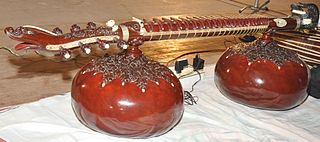
The Rudra veena —also called Bīn in North India—is a large plucked string instrument used in Hindustani classical music, especially dhrupad. It is one of the major types of veena played in Indian classical music, notable for its deep bass resonance.

The vichitra veena is a stick zither, a plucked string instrument used in Hindustani music. Similar to the Carnatic gottuvadhyam it has no frets and is played with a slide.

The Sarasvati vīṇa is an Indian plucked veena. It is named after the Hindu goddess Saraswati, who is usually depicted holding or playing the instrument. Also known as raghunatha veena is used mostly in Carnatic Indian classical music. There are several variations of the veena, which in its South Indian form is a member of the lute family. One who plays the veena is referred to as a vainika.
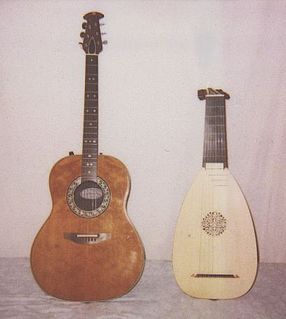
Plucked string instruments are a subcategory of string instruments that are played by plucking the strings. Plucking is a way of pulling and releasing the string in such a way as to give it an impulse that causes the string to vibrate. Plucking can be done with either a finger or a plectrum.
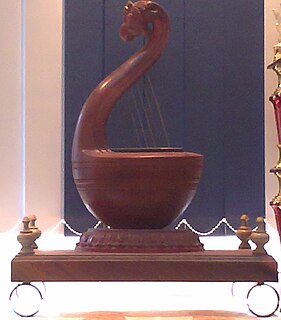
The yazhal is an arched harp used in ancient Tamil music. It was strung with gut strings that ran from an curved ebony neck to a boat or trough-shaped resonator, the opening of which was a covered with skin for a soundboard. At the resonator the strings were attached to a string-bar or tuning bar that laid on top of the soundboard and had holes for the strings. The neck may also have been covered in hide.
The veena is a plucked musical instrument originating from India.
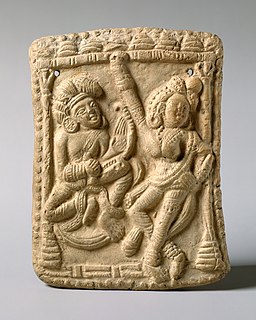
The ancient veena is an early Indian arched harp, not to be confused with the modern Indian veena which is a type of lute or stick zither. Names of specific forms of the arched harp include the chitra vīṇā with seven strings, the vipanchi vīṇā with nine strings and the mattakokila vīṇā a harp or possibly board zither with 21 strings.

The veena, also spelled vina, comprises various chordophone instruments from the Indian subcontinent. Ancient musical instruments evolved into many variations, such as lutes, zithers and arched harps. The many regional designs have different names such as the Rudra veena, the Saraswati veena, the Vichitra veena and others.

Bar zither is class of musical instruments within the Hornbostel-Sachs classification system for a type of simple chordophone, in which the body of the instrument is shaped like a bar.
Misr veena is a plucked stringed musical instrument of Indian origin.
The segankuru is a bowed trough zither, bar zither or musical bow, a string instrument found in Botswana and other areas of South Africa, and found under many names. It consists of a wooden body attached to a tin can resonator, with a single metal string played with a bow. The instruments main role is for self or group entertainment for young men, while herding cattle, etc.

The tube zither is a stringed musical instrument in which a tube functions both as an instrument's neck and its soundbox. As the neck, it holds strings taut and allows them to vibrate. As a soundbox or it modifies the sound and transfers it to the open air. The instruments are among the oldest of chordophones, being "a very early stage" in the development of chordophones, and predate some of the oldest chordophones, such as the Chinese Se, zithers built on a tube split in half. Most tube zithers are made of bamboo, played today in Madagascar, India, Southeast Asia and Taiwan. Tube zithers made from other materials have been found in Europe and the United States, made from materials such as cornstalks and cactus.

The ālāpiṇī vīṇā and the eka-tantrī vīṇā were medieval stick-zither and tube-zither veenas in India, with single strings and gourd resonators. The instruments became prominent in Indian music after 500 C.E. as instruments of court music. They replaced the harp-style veenas and lute-style veenas. The instruments were used in Southeast Asia, both mainland and island nations, and were recorded in sculpture and relief sculpture.
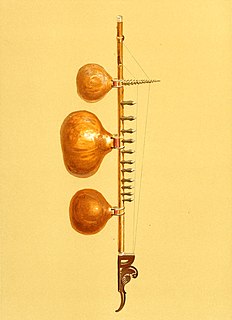
The kinnari vina is a historical veena, a tube zither with gourds attached to act as resonators and frets. It was played in India into the late 19th century and was documented by two European artists. The instrument dates back into medieval times and possibly as far back as 500 C.E. It is closely related to the Alapini Vina and Eka-tantri Vina, the instruments having coexisted in medieval times.

The eka-tantrī vīṇā was a medieval tube-zither veena in India, with a single string and one or more gourd resonators. The instrument became prominent in Indian music in about the 10th century C.E. as instruments of court music. Alongside the alapini vina and kinnari vina it replaced the harp-style veenas and lute-style veenas in sculpture. It was possibly a forerunner of the rudra vina. It shares its name with the modern single-string drone lute, the ektara.

The ālāpiṇī vīṇā was a medieval stick-zither veena in India, with a single string and a gourd resonator. Later forms added more strings. The instruments became prominent in Indian music after 500 C.E. as instruments of court music. Alongside the eka-tantri vina and kinnari vina it replaced the harp-style veenas and lute-style veenas. The instruments were used in Southeast Asia, both mainland and island nations, and were recorded in sculpture and relief sculpture.



















